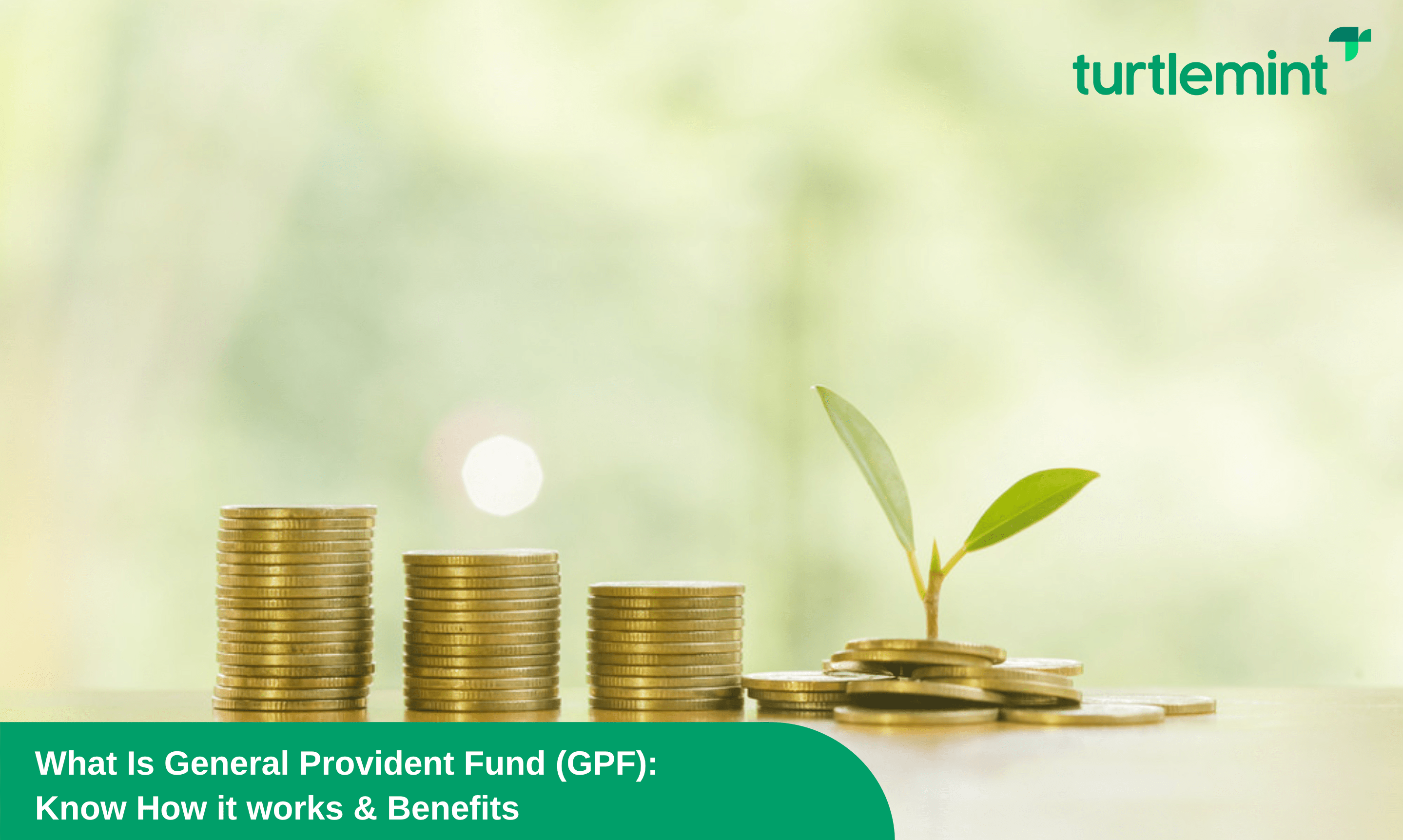
The provident funds allow residents to save funds for retirement with monthly deposits and calculated interest. There are three provident funds, namely, the general provident fund (GPF), the public provident fund (PPF) and the employee’s provident fund (EPF). All the three funds vary in their policies, eligibility, terms and conditions.
General Provident Fund or GPF is a type of provident fund. It’s basically a retirement saving scheme to help Indian government employees to save funds for their retirement. Non-government employees cannot contribute to this scheme.
This article will focus on the general provident fund, its features, benefits, eligibility, and procedures.
Table of Contents
- What is GPF?
- Interest rate of the GPF
- General Provident Fund Features
- Eligibility criteria for GPF
- Steps to open a GPF Account
- withdrawal process of the GPF
- Difference between EPF, PPF & GPF
- Contribution amount of GPF
- Advances of GPF Provident Funds
What is GPF?
GPF is a savings plus retirement scheme for the government employees of India. All the government employees working at different sectors and levels are eligible to benefit from this scheme. They can contribute a certain amount of funds from their salary monthly.
The policy allows employees to save funds on a monthly basis and accumulate the funds and their interest for their retirement. Thus, providing financial security at their elderly age.
These funds are secured and risk-free due to the government’s backup. GPF also provides tax deductions under Section 80 of the Income-tax Act. Furthermore, the interests earned from the GPF provident funds are tax-free.
The interest rate of the General Provident Fund
The interest rates of the GPF are regularly updated by the Department of Pension and Pensioners’ Welfare of India. Ever since its launch in 1968 the Ministry of Finance has regularly updated the interest rates according to the financial needs.
- All sectors of government employees receive the same interest rate
- The interest rate for GPF for the financial year 2021-22 is 7.1%. It is reported that for the last 15 years the interest rates are fluctuating between 8%-7%.
General Provident Fund Features
- GPF Provident Fund is operated by the Department of Pension and Pensioners Welfare. This department is transparently managed by the Ministry of Personnel, Public Grievances, and Pensions.
- All the government employees including temporary (after offering one year’s service), and permanent are eligible to subscribe to the GPF Provident Fund.
- The subscriber of the GPF Provident Fund is required to make his/her family member nominee while filling the prescribed form of the fund. The subscriber can make one or more persons the nominee of his/her fund. The subscriber also decides the share of the payable amount between the nominees after his/her demise.
- The subscribers of the GP Fund get the interest of 7.1% on their deposited money.
- On their last working day in the government office, the money from the GP fund is transferred into the account of the subscriber.
Eligibility criteria for GPF
The eligibility criteria to subscribe to the GPF Fund are given below:
- The government employee should be a citizen of India.
- After offering one year’s service in the public sector, temporary government employees including apprentices and probationers are eligible to subscribe to the GPF fund.
- The employees of the private sector companies are not eligible for the GPF Provident Fund.
- The government employees need to deposit a certain share of their salary to subscribe to the GPF Provident Fund.
Steps to open a GPF Account
The following steps are taken while opening the GPF account:
Step 1: Firstly, the eligible government employee needs to fulfil the form for GPF Fund.
Step 2: Then, that application form is submitted to the Account General of the state.
Step 3: After approval, an account number is provided to the subscriber.
Step 4: Thereafter, the procedure of monthly deduction from the subscriber’s salary is specified. The deducted amount is made to the DDO (Drawing and Disbursing Officer).
Step 5: At the end of the financial year, the subscriber is provided with the annual statement of the GPF fund including credits, debits (loan), accumulated interest (7.1 % interest rate), and closing balance.
The withdrawal process of the General Provident Fund
Some key points to understand the withdrawal process of the GPF Provident Fund are given below:
- GPF funds mature when the government employee is retired. On the last day of work, the accumulated amount of the fund is credited into his/her bank account.
- If the government employee has completed ten years of service in the public sector, then he/she can withdraw the accumulated GPF fund on account of various reasons i.e. marriage. education, medical treatment, construction, purchasing of the consumer durables, travelling expenses, etc. He/she can also withdraw the GPF fund amount within ten years before the date of retirement/superannuation.
- If the government employee is leaving the job before retirement, then he/she is eligible to withdraw the amount from the GPF Provident Fund.
- In case of the demise of the subscriber, the accumulated money of the GPF fund is claimed by his/her nominee.
Difference between EPF, PPF & GPF
Even though EPF, PPF, and GPF all belong to the Provident fund category. They still differ in many aspects. Understanding these differences will enable you to choose the appropriate fund scheme that suits you and your lifestyle.
Here is a tabulation of the differences between these three provident funds.
|
Parameters |
EPF |
PPF |
GPF |
|
Abbreviation |
Employees’ Provident Fund |
Public Provident Fund |
General Provident Fund |
|
Eligibility criteria |
People working in any company that has 20 or more employees |
Include all the Indian resident individuals |
Only Government employees and workers. |
|
Interest rates |
8.5% |
7.1% |
7.1% |
|
Maturity period |
Up to 58 years of age |
15 year period |
Until retirement |
|
Minimum Deposit range |
10% or 12% of the salary or INR 1800 |
INR 500 per year |
6% of their monthly salary |
|
Maximum Deposit range |
Its voluntary no completion is made |
INR 1.5 lakhs per year |
100% of their monthly salary |
|
Premature closure |
Being unemployed for more than 2 months |
Only after 5 years of maturity, for educational and medical reasons |
If the individual leaves their government job |
Contribution amount of GPF
For the regular flow of contribution to the GPF provident fund the Ministry of finance has regulated a certain percentage of income to be allocated towards the fund. The Monthly contribution of the government employees is based on their salaries.
- The minimum monthly contribution should be 6% of the monthly salary of the employee
- The maximum monthly contribution is voluntary and can be even up to 100% of their salary.
Advances of GPF Provident Funds
GPF provident funds allow their subscribers to take advances from the accumulated funds. Let’s look into the provisions for advances of GPF and their rulings.
- The GPF subscriber can request an advance of their funds at any point in their career under certain grounds like medical needs, marriages, education and housing.
- The advances provided are generally around 12 months of funds or three-fourths of the accumulated funds, whichever value is less. However, under special conditions, even 90% of funds are also provided as advances.
- The sanctioning authority must pay the funds to the subscriber within 15 days from the request. No proof documents or procedures are required while applying for advances.
- The advance provided is expected to be refunded within 60 months of instalments. One can take multiple advances during their career. No interest shall apply to these advances.
- If the subscriber needs more advances with incomplete refunding of the previous advances, then the leftover funds are added to the new advance and the subscriber must pay the consolidated funds.
Government employees can do the savings easily with the help of the GPF fund. These savings help one day when the regular salary is not received after retirement. GPF fund helps the employees if they need money during their government service period for various purposes i.e. education of the child, marriage, renovation/construction of the house, travelling expenses, medical expenses, etc. Hence, those who want to have a safe and secure future should subscribe to the GPF provident fund.
Related articles:
FAQs
- How much of my salary will be deducted under GPF?
The minimum deductible value is 6% of the government employee’s monthly salary. However, the subscriber can contribute more if they want.
- Are the funds under GPF taxable?
GPF allows tax deduction under Section 80. No additional taxes are required to be paid over the interest amount that accumulates over the funds.
- Can I borrow money against GPF?
You can request up to 75% of the advances from your GPF. No interests are calculated over these loans.
- What if I quit my job in between, what happens to my funds?
When the subscriber quits their job they can withdraw the funds from GPF regardless of their career period. No additional charges or deductions are made over these premature withdrawals.
Disclaimer
This article is issued in the general public interest and is for educational purposes only. The blogs should not be used as a substitute for competent expert advice from a licensed professional to best suit your needs. Insurance is a subject matter of solicitation. For more details on policy terms, conditions, exclusions, limitations, please refer/read policy brochure before concluding sale.

































